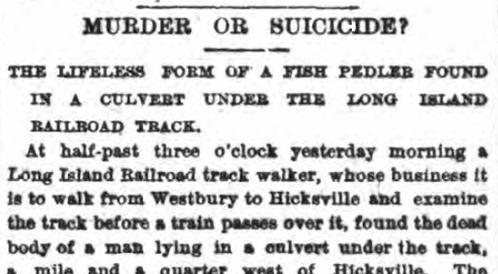The News
The first reports, written only hours after Thomas Cahill's gruesome find, opined that the death of Rhodes could not have been accidental.

New York Herald, December 18, 1879
The typo notwithstanding, the Herald seemed quite certain that the death was intentional.
The nearest crossing at which a wagon could turn - intentionally or not - to get onto the tracks was a half-mile distant. Had it gained the track accidentally, the constant bumping would have alerted the driver to his error. Regardless, there were no wheel ruts that led from that crossing onto the track. Indeed, up on the embankment the wheel ruts began only 200 yards east of the wreckage. It would have been impossible for the horse to pull the wagon from there to where the wagon had fallen, because along the way the animal would have had to walk over a cattle guard (i.e., a frame with many openings, recessed between the rails so that a cow or horse would stumble, and not be able to continue walking along the track). Some people were speculating that the wagon had been carried up the embankment by a group of men. And the wreckage didn't look right, either: there was damage that could not have resulted from a plunge to the ground. How had whatever happened to the wagon not injured the horse? Although the wagon's shafts were broken, part of them remained connected to the harness that the horse wore. And of course, the driver's body and the wreckage were found on opposite sides of the embankment. This was no accident.
A gory puzzle like this one would be in the news for quite some time - but as things turned out, it wasn't.
***

